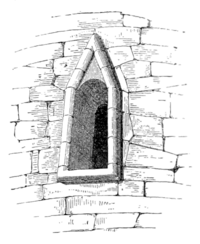concentric and receding arch-mouldings, and has a richly decorated pediment over its external arch. The basso relievo on the lintel of this doorway represents a helmeted centaur, shooting with an arrow at a lion, which appears to tear some smaller animal beneath its feet." P. 290.
The peculiar kind of double base which occurs in this chapel is found also in several of these Irish buildings, and may be regarded as another provincialism.
The two following illustrations will serve as examples of the most peculiar of the windows, the first representing one of the small round windows at the east end of the croft over the chancel of Cormac's church; and the second, one of the windows in the round tower of Timahoe.
Another very interesting feature in Mr. Petrie's valuable work consists of the number of examples with which he has furnished us of early tombstones, sometimes with inscriptions only, of which two specimens have already been given; others ornamented with crosses, and with the interlaced work usually called the Runic knot, which Mr. Petrie considers to have been in use in Ireland long anterior to the irruption of the Danes. These ornaments Mr. Petrie supposes to have been most used "during the ninth and tenth centuries, after which I have seen no example of it on such monuments." He gives examples also of several other figures of similar character, though not exactly the same, one of the most interesting of which is "the tombstone of the celebrated Suibine Mac Maelhumai, one of the three Irishmen who visited Alfred the Great in the year 891, and whose death is



